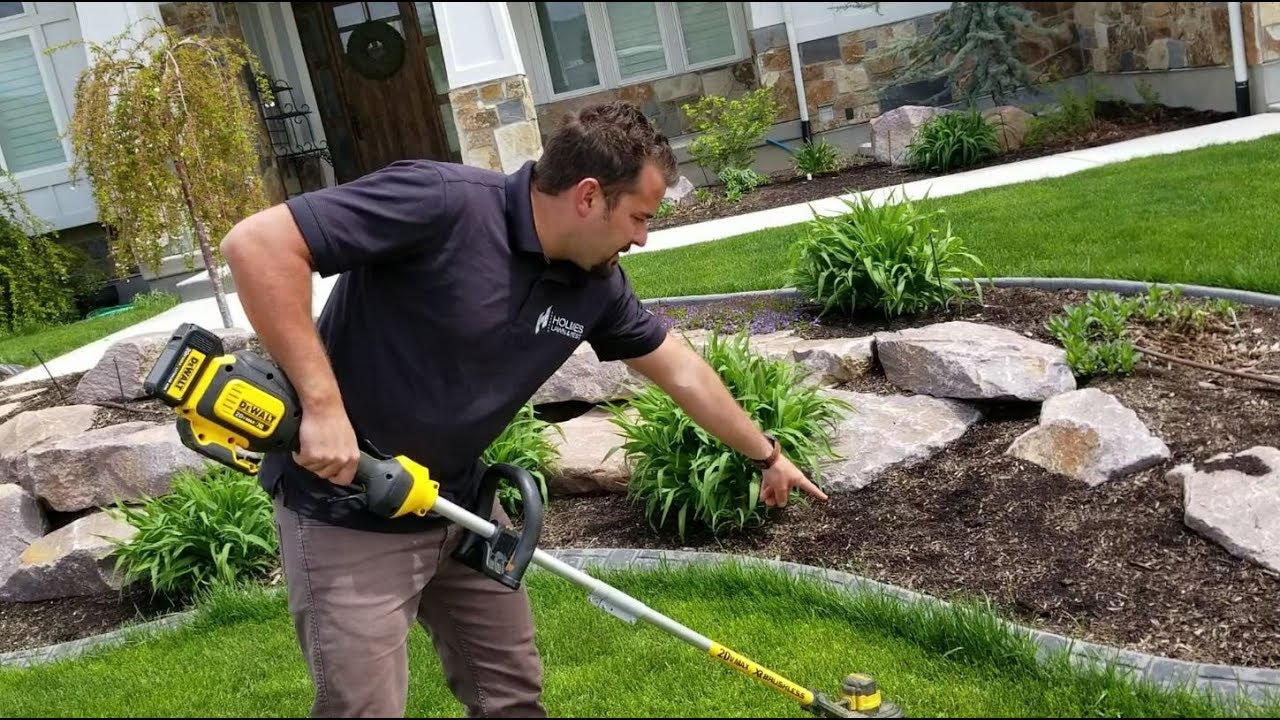To keep grass out of flower beds when trimming, use a barrier such as landscaping fabric or edging to create a separation between the grass and the flowers. Maintaining the neat appearance of your flower beds can be a daunting task, especially when grass starts creeping in.
The intermingling of grass and flowers not only creates a messy and unkempt look but also competes for resources, leading to stunted growth and potential damage to your plants. Fortunately, there are effective ways to keep grass out of your flower beds when trimming.
By using barriers, such as landscaping fabric or edging, you can create a physical separation that prevents grass from encroaching on your flowers. We will explore these methods in detail, providing you with actionable tips for maintaining a clean and vibrant garden.

Credit: backyardnow.net
Understanding The Challenge
The Importance Of Maintaining A Clean And Neat Flower Bed
A well-maintained flower bed is not only aesthetically pleasing but also vital for the health of your plants. Here’s why it’s essential to keep your flower beds clean and neat:
- Weed control: By regularly clearing grass from your flower beds, you prevent weeds from taking root and competing for resources with your plants.
- Enhanced visual appeal: A tidy flower bed with no grass encroachment creates a clean and vibrant appearance, making your garden more inviting.
- Disease prevention: Grass in flower beds can harbor pests and diseases that can quickly spread to your plants, damaging their health and growth.
- Improved nutrient absorption: When grass competes with flowers for nutrients in the soil, it restricts their growth and can lead to stunted or unhealthy plants.
The Common Problem Of Grass Encroachment
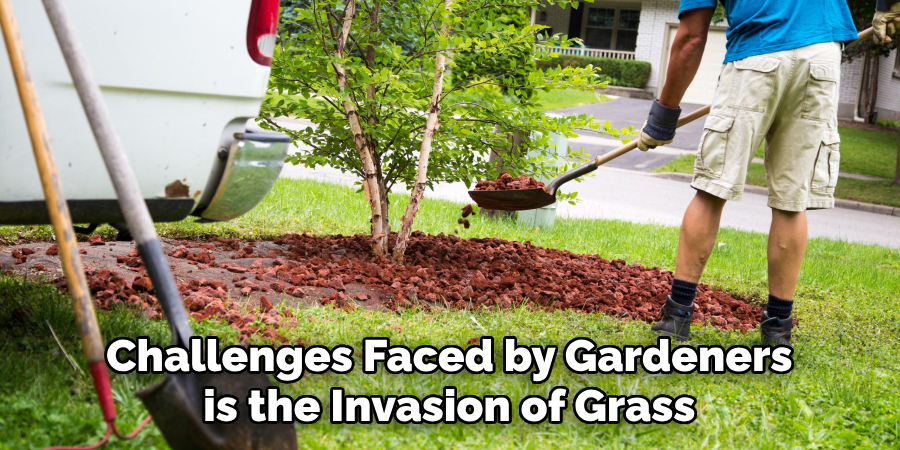
One of the most common challenges faced by gardeners is the invasion of grass in their flower beds. Grass shooting up among delicate flowers can be frustrating, but with the right knowledge and techniques, you can overcome this issue.
Causes Of Grass Growth In Flower Beds
Understanding the reasons behind grass growth in your flower beds can help you develop effective strategies to prevent it. Here are some common causes:
- Nearby lawn proximity: If your flower beds lie close to the lawn area, grass can spread through rhizomes or creeping stems.
- Lawn mowing technique: Improper lawn mowing, such as mowing too close to the flower bed edges, can result in grass clippings settling into the beds and taking root.
- Wind dispersal: Grass seeds can be carried by wind and land in your flower beds, leading to new growth.
- Inadequate edging: Insufficient or poorly installed edging materials can allow grass to infiltrate flower beds over time.
Now that you understand the challenge of grass encroachment and the importance of maintaining neat flower beds, it’s time to discover strategies and techniques to keep grass out of your flower beds when trimming. Stay tuned for our next blog post installment, where we’ll provide you with practical tips and solutions to combat this problem effectively.
Preparing Your Tools And Materials
Grass infiltrating flower beds can be a persistent nuisance for gardeners. Not only does it compete with your beautiful blooms for nutrients, but it also detracts from the overall aesthetic appeal of your garden. If you find yourself constantly battling grass invasion, then it’s time to take action.
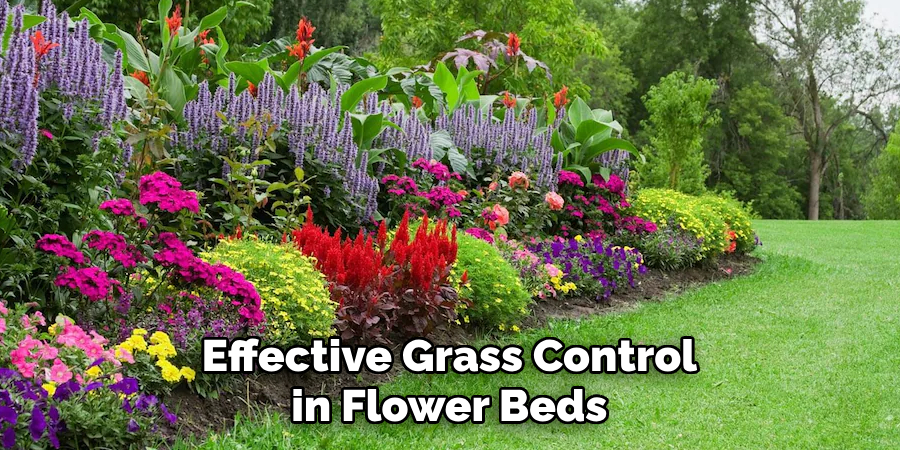
In this section, we will delve into the essential tools for effective grass control in flower beds, the importance of protective gear and equipment, and selecting the right herbicides or natural alternatives.
Essential Tools For Effective Grass Control In Flower Beds
Maintaining a well-tended flower bed requires the use of suitable tools, ensuring your efforts yield desired results. Here are some essential tools you should consider:
- Hand pruners: Ideal for precision trimming and removing grass around delicate plants.
- Weed trimmers: Designed specifically to trim grass and weeds in hard-to-reach areas.
- Edging spade: Helps create a clear separation between the lawn and flower bed, keeping grass from encroaching.
- Garden hoe: Useful for cultivating the soil and uprooting shallow grass roots.
- Lawn mower with bag attachment: Collects grass clippings before they have a chance to infiltrate your flower beds.
The Importance Of Protective Gear And Equipment
Before you embark on your grass control mission, it’s crucial to prioritize safety. Protecting yourself and the environment is paramount. Here’s why protective gear and equipment are important:
- Gloves: Shield your hands from potential cuts, thorns, or harmful chemicals found in herbicides.
- Closed-toe shoes: Prevent accidental injuries from garden tools or concealed hazards in the flower bed.
- Safety glasses: Guard your eyes against flying debris when trimming grass.
- Respirator mask: Protect yourself from potentially harmful herbicide fumes or allergens.
- Apron or gardening smock: Keep your clothes clean and protect yourself from chemical spills.
Selecting The Right Herbicides Or Natural Alternatives
When it comes to grass control in flower beds, you have the option of using herbicides or natural alternatives. Before making a choice, consider the following:
- Herbicides: Choose herbicides specifically formulated for grass control in flower beds. Ensure they are labeled safe for use around your desired plants.
- Natural alternatives: Explore organic options such as vinegar, boiling water, or homemade herbicidal soaps. These can be effective in suppressing grass growth without harming your flowers.
- Consult with experts: Seek advice from local horticulturists or garden centers to identify the most suitable herbicides or natural alternatives for your specific situation.
Remember to follow the application instructions carefully and exercise caution while using any chemicals in your garden. By being proactive and taking the necessary steps to keep grass out of your flower beds, you can enjoy a beautiful, thriving garden without the intrusion of unwanted grass.
Implementing Best Practices
Keeping grass out of flower beds when trimming requires implementing best practices. By following these strategies, you can maintain the beauty of your flower beds and prevent the hassle of constantly clearing out unwanted grass.
Clearing The Flower Bed Of Grass Before Trimming
Before you start trimming, it’s crucial to clear the flower bed of any existing grass. This ensures that you have a clean canvas to work with and reduces the chances of grass infiltrating the bed during the trimming process. Here are some key points to keep in mind:
- Start by removing any visible grass and weeds from the flower bed manually or using a garden tool like a trowel or hand weeder.
- Be thorough in removing the grass roots to prevent regrowth.
- Take extra care when working around delicate flowers and plants to avoid damaging them.
Using Barriers And Edging To Prevent Grass Infiltration
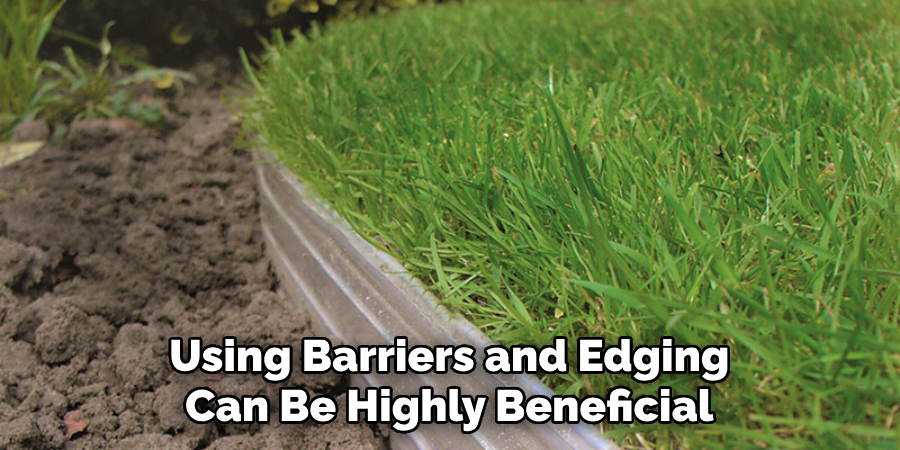
To effectively keep grass out of your flower beds, using barriers and edging can be highly beneficial. These methods create a physical barrier that prevents grass from encroaching on your plants. Consider the following points:
- Install plastic or metal edging around the perimeter of your flower beds to create a clear separation between the grass and the bed.
- Choose a barrier material that is sturdy and durable to withstand potential pressure from grass roots or external factors.
- Ensure the edging is properly installed by digging a trench and securing it firmly in place.
Mulching For Suppressing Grass Growth And Retaining Moisture
Mulching is another effective method to suppress grass growth in flower beds. Mulch not only creates a visual appeal but also helps retain moisture and inhibits weed growth. Consider these suggestions:
- Apply a layer of organic mulch around your flower beds, such as wood chips, straw, or shredded bark.
- Make sure the mulch layer is at least 2 to 3 inches thick to effectively suppress grass growth.
- Monitor the mulch regularly to ensure it remains at the recommended thickness and replenish it as needed.
By implementing these best practices, you can keep grass out of your flower beds when trimming, ensuring your plants stay healthy and vibrant. Remember to clear the flower bed of grass before trimming, use barriers and edging to prevent grass infiltration, and mulch for suppressing grass growth and retaining moisture.
With these strategies in place, your flower beds will be free of unwanted grass and your plants will thrive.
Method 1: Manual Grass Removal Techniques
Hand Pulling Grass Roots To Eliminate Growth
One effective method for keeping grass out of flower beds when trimming is to manually pull out the grass roots. This technique ensures that the grass is completely removed, preventing future growth and invasion of the flower beds. Here are some key points to keep in mind:
- Begin by wearing gardening gloves to protect your hands from any sharp objects or thorns that may be present in the flower beds.
- Identify the grass roots by looking for the base of the grass blades where they emerge from the soil.
- Firmly grasp the grass at the base and pull upward, making sure to remove not only the grass blades but also the entire root system.
- If the grass roots are deeply embedded in the soil, use a small handheld garden shovel or trowel to loosen the soil around the roots and make it easier to pull them out.
- Dispose of the grass properly, either by adding it to your compost pile or placing it in a biodegradable bag for disposal.
Using Weeding Tools For Precision And Efficiency
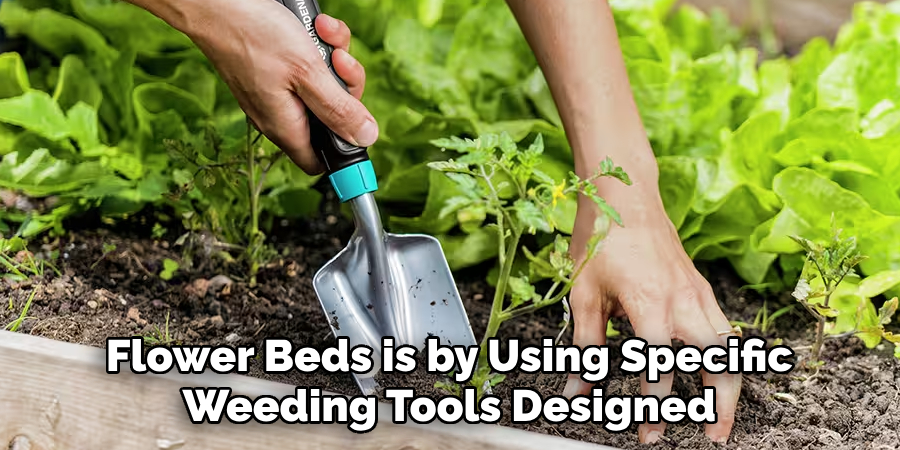
Another method to effectively keep grass out of flower beds is by using specific weeding tools designed for precision and efficiency. These tools allow you to target grass growth without disturbing the surrounding plants. Consider the following points:
- Invest in high-quality weeding tools such as a hand-held weeder or a long-handled dandelion weeder.
- Before using the weeding tools, make sure the soil is slightly damp. This will make it easier to remove the grass roots without breaking them or leaving any fragments behind.
- Position the weeder as close to the base of the grass plant as possible and press down firmly to ensure you are removing the entire root system.
- Use a rocking motion to lever the weeder and lift the grass out of the soil. This helps prevent the grass from breaking and ensures complete removal.
- Regularly clean the weeding tools to prevent the spread of weeds or diseases between flower beds.
Regular Inspection And Maintenance Of Flower Beds
Regular inspection and maintenance of flower beds play a crucial role in keeping grass out. This proactive approach helps identify and address grass growth issues before they become major problems. Here’s what you need to do:
- Regularly walk through your flower beds and visually inspect for any signs of grass invasion.
- If you spot any grass, immediately employ the hand pulling or weeding tools techniques mentioned above to remove it.
- Be vigilant and inspect the flower beds after each mowing session to catch any stray grass clippings that may have landed in the beds.
- Consider installing landscape edging or barriers to create a clear separation between the lawn and flower beds, preventing grass from encroaching.
- Mulching the flower beds can also help suppress grass growth by blocking sunlight and providing a physical barrier.
By incorporating these manual grass removal techniques, you can effectively keep grass out of your flower beds when trimming. Regular inspection and maintenance will help keep your flower beds looking pristine and free from unwanted grass growth.
Method 2: Chemical Grass Control
Maintaining a neat and tidy flower bed can be quite a challenge, especially when it comes to keeping grass from infiltrating your carefully planted flowers. While regular trimming is necessary to keep the grass at bay, there are times when grass seems to stubbornly persist.
In such cases, chemical grass control methods can provide an effective solution. In this section, we will explore the key points of using herbicides to keep grass out of flower beds, from choosing the appropriate herbicide to proper application and safety precautions, as well as long-term considerations and potential drawbacks.
Choosing The Appropriate Herbicide For Your Flower Bed
- Consider the type of grass: Different herbicides are formulated to target specific grass types, so it’s essential to identify the type of grass invading your flower bed.
- Select a selective herbicide: These herbicides target grass while leaving your flowers unharmed.
- Look for residual control: Herbicides with residual control continue to suppress grass growth for an extended period, minimizing the need for frequent applications.
Proper Application And Safety Precautions To Follow
- Read the label instructions: Carefully follow the instructions provided by the manufacturer to ensure proper usage and effectiveness.
- Time your application: Apply the herbicide when the grass is actively growing to maximize its efficacy.
- Apply in favorable weather conditions: Avoid using herbicides on windy days or during rainfall to prevent drift and runoff.
- Protect yourself: Wear protective clothing, gloves, and safety goggles when applying herbicides to minimize direct contact and potential harm.
- Keep children and pets away: Ensure the product has dried before allowing children and pets access to the treated area.
Long-Term Considerations And Potential Drawbacks
- Understand limitations: Herbicides are not a one-time solution. They require regular application to control grass growth effectively.
- Monitor for resistance: Over time, grass may develop resistance to a particular herbicide, necessitating a switch to an alternative product.
- Potential harm to desirable plants: Misapplication or drift of herbicide can harm surrounding flowers, so take care to protect your desired plants during treatment.
- Environmental impact: Herbicides can have an impact on the environment, so it’s important to choose options with minimal long-term effects and follow proper disposal guidelines.
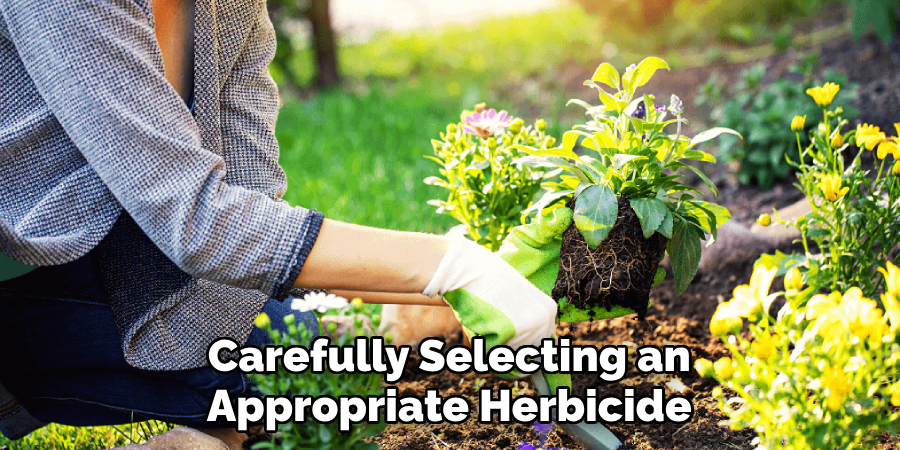
By carefully selecting an appropriate herbicide, following application instructions, and considering long-term effects, you can effectively keep grass out of your flower beds while maintaining the health and beauty of your cherished blooms. Remember to choose herbicides wisely, adhere to safety precautions, and take into account potential drawbacks to achieve a flawless flower bed free from unwanted grass.
Method 3: Natural Grass Control Alternatives
Tired of battling the constant invasion of grass in your flower beds every time you trim? Look no further! Here are some effective natural grass control alternatives that will help you keep your flower beds looking pristine without the use of harmful chemicals.
Using Organic Mulch To Suppress Grass Growth:
- Mulching with organic materials such as wood chips, straw, or bark is not only aesthetically pleasing but also acts as a barrier to prevent grass from infiltrating your flower beds.
- Apply a layer of mulch about 2-3 inches thick around your plants to create a protective barrier that inhibits grass growth and helps retain moisture in the soil.
- Organic mulch also improves soil quality, provides insulation during extreme temperatures, and helps control weed growth by blocking sunlight.
Utilizing Homemade Weed Killers And Deterrents:
- Create a mixture of vinegar, water, and dish soap in a spray bottle to make a natural weed killer. Spray this solution directly on unwanted grass in your flower beds to suppress its growth. Be careful not to spray it on your desirable plants as it may harm them too.
- Boiling water is another effective weed deterrent. Carefully pour boiling water over the grass to kill it at the roots and prevent regrowth.
- Saltwater, when used sparingly, can also be an organic grass killer. Dissolve salt in water and apply it selectively to the grass, taking care not to oversaturate the soil or expose nearby plants to excessive salt.
Promoting Healthy Soil And Plant Growth For Weed Prevention:
- Maintaining healthy soil is key to preventing grass from taking over your flower beds. Ensure the soil is well-drained, enriched with organic matter, and properly aerated.
- Encourage strong plant growth by fertilizing your flowers regularly. Healthy, robust plants naturally compete with grass and minimize its growth.
- Regularly remove any grass shoots or runners that find their way into your flower beds before they have a chance to establish and spread.
- Consider using landscape fabric or weed barriers in combination with organic mulch to further suppress grass growth and maintain a neat appearance.
With these natural grass control alternatives, you can bid farewell to the endless battle against invasive grass in your flower beds. Embrace these eco-friendly methods, and enjoy the visual appeal of well-maintained, grass-free gardens.
Essential Tips And Maintenance Strategies
Grass can often be a persistent intruder in our flower beds, competing with our precious blooms for sunlight, water, and nutrients. To maintain the beauty and health of our flower beds, it is important to take proactive measures to keep grass out when trimming.
Here are some essential tips and maintenance strategies to help you successfully tackle this challenge:
Regularly Monitoring Flower Beds For New Grass Growth
- Inspect frequently: Regularly check your flower beds to spot any signs of new grass growth. Prevention is key, and early detection will help you address the issue before it becomes overwhelming.
- Address promptly: As soon as you notice grass infiltrating your flower beds, take immediate action. The longer you wait, the more established and difficult to remove the grass becomes.
- Hand-pulling technique: For small patches of grass, manually remove them by gently pulling from the base. Ensure you remove the entire root system to minimize regrowth.
- Use a garden tool: For larger areas, employ a hand trowel or a dandelion weeder to dig out the grass roots effectively. Be careful not to disturb the flower roots in the process.
- Dispose properly: Dispose of the grass clippings or pulled grass away from your flower beds to prevent accidental reseeding.
Priming The Flower Bed For Optimal Growth Conditions
- Prepare the soil: Before planting any flowers, ensure the soil is properly prepared. By loosening and cultivating the soil, you create an ideal environment for your flowers to grow, while also making it more challenging for grass to take root.
- Apply mulch: Spread a layer of organic mulch, such as wood chips or straw, over your flower beds. Mulch acts as a natural barrier, preventing grass and weed growth while retaining moisture and regulating soil temperature.
- Edge the flower bed: Install an edging material or create a physical barrier surrounding your flower bed. This will help prevent grass encroachment from the surrounding lawn.
- Maintain proper spacing: When planting flowers, provide adequate spacing between each plant. This not only allows for proper airflow and sunlight penetration but also reduces the chances of grass invading the bed.
Adjusting Trimming Techniques To Minimize Grass Intrusion
- Selective trimming: When trimming near flower beds, take a careful and precise approach. Trim grass near the bed edges, ensuring a clean and defined border. This minimizes the chances of grass encroaching into the flower bed.
- Raise the mower deck: Adjust your lawn mower’s cutting height to a level that leaves grass at least two inches tall. Keeping the grass slightly longer promotes shading, making it difficult for weed and grass seeds to germinate and establish.
- Avoid over-trimming: While it may be tempting to cut grass excessively short, especially near flower beds, avoid the temptation. Longer grass blades provide natural shading and also encourage a deeper and healthier root system.
- Regular maintenance: Adopt a consistent lawn maintenance schedule, including regular mowing, watering, and fertilizing, to ensure the overall health of your lawn. A healthy lawn is better equipped to compete and suppress grass growth in flower beds.
By incorporating these essential tips and maintenance strategies into your gardening routine, you can keep grass out of your flower beds, allowing your blooms to thrive and take center stage. Regular monitoring, proper soil preparation, and adjusting trimming techniques are the key to maintaining a beautiful and weed-free garden.
Frequently Asked Questions Of How To Keep Grass Out Of Flower Beds When Trimming
How Can I Prevent Grass From Growing In My Flower Beds?
To prevent grass from growing in your flower beds, you can apply a layer of mulch or use a weed barrier fabric. Regularly pulling out any grass that does grow and using a trimmer with a guard can also help keep your flower beds grass-free.
What Is The Best Way To Trim Grass Near Flower Beds?
The best way to trim grass near flower beds is to use a trimmer with a guard or an edger. This will ensure that you can easily maneuver around the flower beds without damaging any plants. Additionally, it’s important to trim the grass regularly to prevent it from encroaching on your flower beds.
Is It Necessary To Maintain A Gap Between Grass And Flower Beds?
Yes, it is necessary to maintain a gap between grass and flower beds. This gap helps to prevent grass from growing into your flower beds and competing for resources with your plants. It also makes it easier to trim and maintain your flower beds without damaging any flowers or plants.
Conclusion
Maintaining a weed-free flower bed can be a challenge, but with a few simple tips and tricks, you can keep grass from invading your beautifully manicured garden. Regular trimming and edging are crucial in preventing grass from encroaching on flower beds.
By creating a clear boundary between the grass and the flower bed, you can minimize the chance of grass spreading. Mulching is another effective method to keep grass at bay. Applying a layer of mulch around the plants helps to inhibit weed growth and retains moisture in the soil.
Additionally, using landscape fabric or weed barriers can further prevent grass from infiltrating your flower beds. Remember to also be mindful of the type of grass you have in your lawn, as some varieties are more aggressive and invasive than others.
By following these techniques and being vigilant in your lawn maintenance, you can enjoy beautiful, grass-free flower beds all season long.

